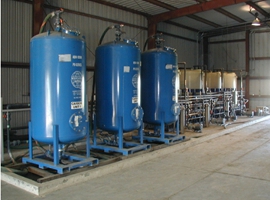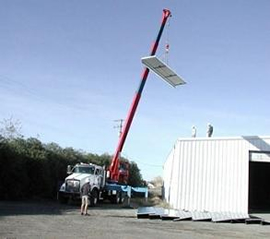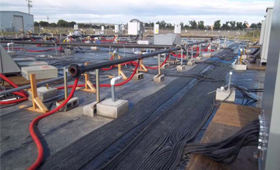Green Remediation Focus
Frontier Fertilizer Superfund Site
Davis, California
Superfund NPL
Cleanup Objectives: Remove pesticides, carbon tetrachloride, and other contaminants of concern (COCs) from groundwater and soil on an 18-acre former industrial site.
Green Remediation Strategy: Implement energy conservation measures to reduce the existing groundwater pump-and-treat (P&T) system's energy demand, maximize use of renewable energy to operate the P&T system, reduce duration of P&T operation by treating soil continuing to act as the source of groundwater contamination, and identify beneficial reuse options for treated groundwater. Implementation of the strategy has involved:
- Replacing a conventional 10-hp pump used to discharge treated water to the municipal sewer system with an alternate gravity-feed pipe system nine years after P&T startup.
- Equipping the groundwater extraction pumps with variable frequency drives (VFDs) in all (16) extraction wells, which enable water pumps to accommodate fluctuating demand by adjusting their motor speed, rather than pumping in an energy-consuming start-stop pattern.
- Installing a small (5.7-kW) rooftop photovoltaic (PV) system in 2007 on the existing groundwater treatment building; the onsite solar PV capacity was expanded after three years by installing 336 (68.9-kW) ground-mounted PV modules on 0.5 acres.
- Participating in the EPA's nationwide Renewable Energy Certificate (REC) program as a partner in EPA's Green Power Prtnership.
- Utilizing in situ thermal treatment (ISTT) to accelerate COC removal in source area soil and reduce duration of P&T operations. ISTT involved operating an in situ electrical resistive heating (ERH) system comprising 111 subsurface electrodes at treatment depths of 40 to 80 feet below ground surface (bgs), and 128 shallow electrodes in areas where treatment was needed at depths of less than 10 feet bgs.
- Forming a federal-state team to study water reuse options such as reinjection of the treated water (rather than release to the sanitary sewer system), as well as related issues such as nearby property ownership, transportation corridors, and infrastructure costs.
Results:
- Treating an average of 1.54 million gallons of extracted groundwater monthly, which has led to the removal of an average of 0.7 pounds of COCs each month and a total of approximately 1,500 pounds since P&T startup in 1995.
- Reducing energy demand by 25% and saving $7,000 in electricity-related operating costs each year since the transition from an electric pump to a gravity-feed discharge pipe in 2004. Capital costs for the pipe, including installation, totaled approximately $20,000.
- Additionally reducing electricity consumption since 2006 through use of VFDs. Near-term return on the $45,000 capital costs for the VFDs is anticipated through stabilization of pump speed and water flow through the treatment process, as well as a reduction in equipment stress caused by frequent start-stop cycles.
- Offsetting 100% of the P&T system's demand for grid-supplied electricity by annually generating about 8,000 kWh through the small rooftop PV system and 101,125 kWh through the ground-mounted PV array (a total of approximately 109,125 kWh each year).
- Saving an average of $12,000 in operating expenses each year through PV-system net metering with the local electricity provider, based on 2014 electricity prices.
- Avoiding an estimated 147,500 pounds in carbon dioxide (equivalent) emissions each year through renewable energy use.
- Anticipating a 14-year return on the $350,000 investment for the ground-mounted PV system, which has an expected lifespan of 20 years. This capital cost was partially reimbursed by a $100,000 rebate under the California Energy Commission's Renewable Energy Program.
- Removed nearly 80 pounds of COCs and remediated about 52,000 cubic yards of source area soil through ERH, which used an estimated total of 7,000,000 kWh of electricity. Aggressively treating the source area soil and groundwater through high-temperature heating over 19 months is anticipated to significantly reduce duration of the P&T system used to control and treat the associated groundwater plume, from an estimated 200 years to about 30 years.
- Reduced energy demand on the electrical grid during ERH treatment by operating the system in three sequential stages from March 2011 to October 2012.
- Applied 2,506 MWh RECs in 2011 and 7,656 MWh RECs in 2012 through the EPA nationwide REC program to offset the electrical energy usage for the ERH.
Property End Use: Light industrial or office park
Point of Contact: Bonnie Arthur, U.S. Environmental Protection Agency, Region 9
Update: July 2015











